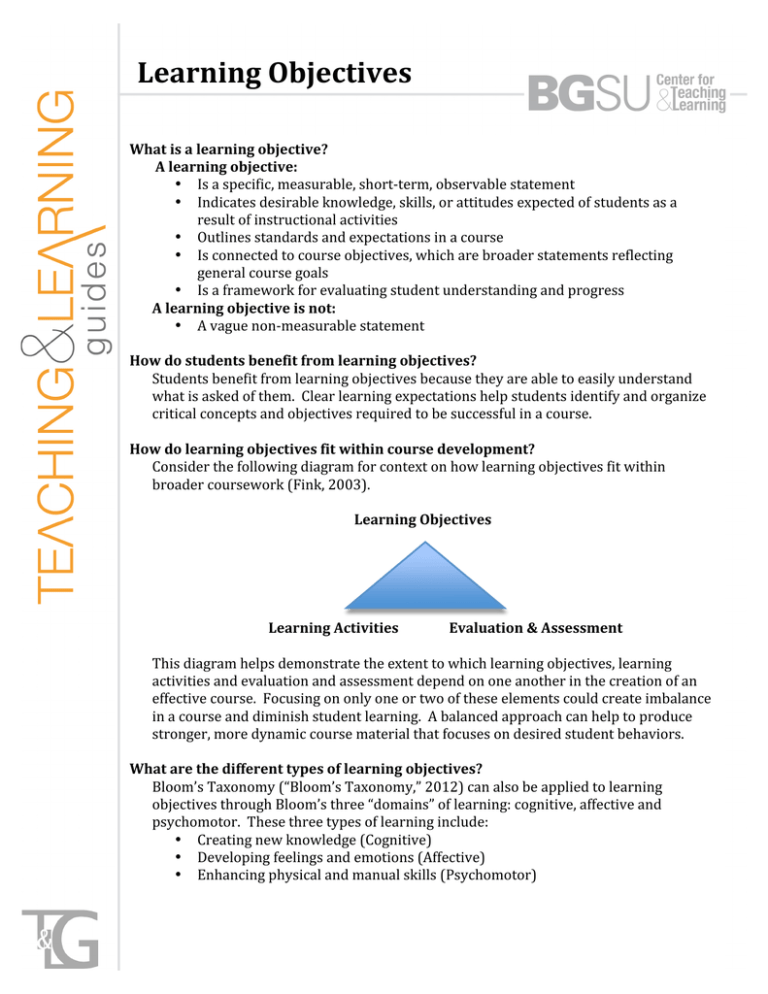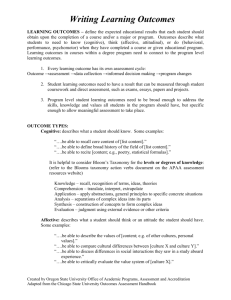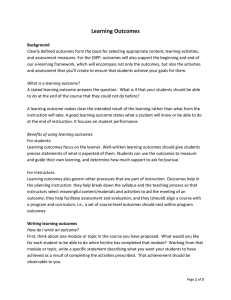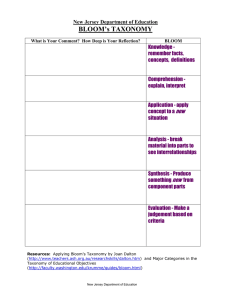Learning Objectives
advertisement

Learning Objectives What is a learning objective? A learning objective: • Is a specific, measurable, short‐term, observable statement • Indicates desirable knowledge, skills, or attitudes expected of students as a result of instructional activities • Outlines standards and expectations in a course • Is connected to course objectives, which are broader statements reflecting general course goals • Is a framework for evaluating student understanding and progress A learning objective is not: • A vague non‐measurable statement How do students benefit from learning objectives? Students benefit from learning objectives because they are able to easily understand what is asked of them. Clear learning expectations help students identify and organize critical concepts and objectives required to be successful in a course. How do learning objectives fit within course development? Consider the following diagram for context on how learning objectives fit within broader coursework (Fink, 2003). Learning Objectives Learning Activities Evaluation & Assessment This diagram helps demonstrate the extent to which learning objectives, learning activities and evaluation and assessment depend on one another in the creation of an effective course. Focusing on only one or two of these elements could create imbalance in a course and diminish student learning. A balanced approach can help to produce stronger, more dynamic course material that focuses on desired student behaviors. What are the different types of learning objectives? Bloom’s Taxonomy (“Bloom’s Taxonomy,” 2012) can also be applied to learning objectives through Bloom’s three “domains” of learning: cognitive, affective and psychomotor. These three types of learning include: • Creating new knowledge (Cognitive) • Developing feelings and emotions (Affective) • Enhancing physical and manual skills (Psychomotor) Learning objectives can also be scaffolded so that they continue to push student learning to new levels in any of these three categories. For example: Level One Level Two Cognitive objective …list three characteristics …list six characteristics associated with… associated with… Affective objective …identify your personal …empathize with the view view of XYZ issue… of another person culturally on XYZ issue… Psychomotor objective …walk length of balance …walk length of balance beam… beam in six seconds… What can be measured by a learning objective? According to Fink (2003) there are six categories for “significant learning” that identify content assessed by learning objectives. These categories give additional depth to both cognitive and affective objectives. • Fundamental Knowledge: How much course knowledge students retain about a topic • Application: How well students apply concepts in one area of a course or field of study to another topic • Integration: How seamlessly students integrate materials of a course with other materials • Human Dimension: How does learning relate to each individual • Caring: How course material relates to future studies • Learning How to Learn: How course activity challenges students to evaluate their personal learning What are the components of a learning objective? The ABCD (audience, behavior, condition, and degree) method can be used to identify all core components of a learning objective. 1. Audience (the learners) ‐ Who will be doing the behavior? 2. Behavior (performance) ‐ What should the learner be able to do? It is important to make sure the behavior is seen or heard. 3. Condition ‐ Under what conditions do learners demonstrate their mastery of the objective? 4. Degree (or criterion) ‐ How well must the learned behavior be done? Common degrees include: speed, accuracy, quality, and quantity. Example: Each [course participant] should be able to [list] [three characteristics] that make the family medicine physician distinctive from other specialists in the health care system. In this example the primary parts are: Audience “. . . course participant . . .” Behavior “. . . list . . .” Condition Through an exam Degree “. . . three characteristics . . .” How are learning objectives assessed? It is important to assess objectives continually. Each semester/year objectives can be further refined to define desired learning. 1. Apply the following questions based upon the ABCD model to test objectives. a. Does the audience need to be changed? To modify the above objective, consider changing audience to pairs, groups, or a whole course of students. b. Does the behavior being required of students most effectively practice the desired learning material? To modify the above objective, consider changing behavior from listing components of a topic to writing in detail about one component of a topic. c. Is the condition chosen appropriate to document learning? To modify the above objective, consider changing the condition from an examination to an in‐class assignment. d. Is the degree of learning required appropriate? To modify the above objective, consider changing the requirements from three thoughts to one or five. References A quick guide to writing learning objectives. (2012). Retrieved on November 28th 2011 from http://nwlink.com/~donclark/hrd/templates/objectivetool.html Articulate your learning objectives. (2011). Retrieved on November 28th 2011 from http://www.cmu.edu/teaching/designteach/design/learningobjectives.html Bloom’s taxonomy of learning domains. (2011). Retrieved on January 25th 2012 from http://www.nwlink.com/~donclark/hrd/bloom.html Fink, D. L. (2003) Creating Significant Learning Experiences. San Francisco, CA: Jossey‐Bass. Learning objectives: Stems and samples. (2011). Retrieved on November 28th 2011 from http://www.educationoasis.com/instruction/bt/learning_objectives.htm Pedagogy merlot. (2011). http://pedagogy.merlot.org/LearningObjectives.htm Writing learning objectives. (2011). Retrieved on November 28th 2011 from http://www.oucom.ohiou.edu/fd/writingobjectives.pdf



